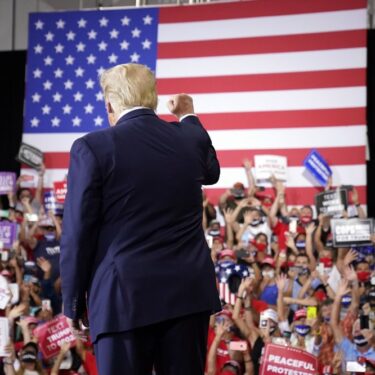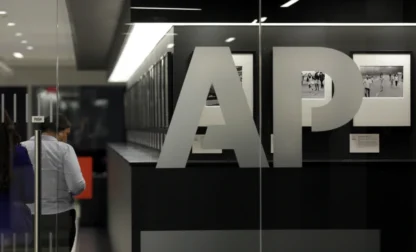By DAVID BAUDER, The Associated Press

NEW YORK (AP) — When the coronavirus shutdown began, ABC News’ Martha Raddatz figured her plan for a cross-country road trip to meet voters would be shelved, too.
Instead, this week Raddatz nears the end of a 6,000-mile journey, where in Ohio she found a man who said President Trump “almost walks on water.” She’s made accommodations, been careful with masks and distancing, arranged interviews ahead of time and is avoiding a cliche of political reporting for safety’s sake.
“I have a no-diner rule,” she said.
The pandemic that instantly changed the 2020 presidential campaign forced news organizations to reevaluate coverage plans, too. It’s an ongoing process: several reporters who followed Trump to Nevada on Sunday stayed outside when they learned the president’s rally would be held indoors.
For months, news executives wondered if they would be covering a campaign without campaigning, although it has grown more public after Labor Day.
“In a way, it gave us an opportunity to reassess how we do things,” said Peter Wallsten, senior politics editor at The Washington Post. “It’s not clear whether how the media has been covering campaigns in the past has been the right way.”
Given a result that took many people by surprise in 2016, one thing virtually all news organizations planned for this year was to talk to more voters, particularly in swing states.
Restrictions on travel and safety concerns made that more difficult.
The New York Times built a network of freelancers in key states, many of them experienced journalists who had lost jobs in the industry’s downturn. The newspaper has three in Wisconsin, a competitive state that also became the incubator of racial justice protests.
“I don’t want to be in New York making assumptions about what independent voters in the Milwaukee suburbs are feeling about Donald Trump or Joe Biden,” said Patrick Healy, the Times’ political editor.
The journalists have spotted stories that may not be strictly political but give insight into what communities are thinking about. Healy cited Kathleen Gray’s June piece on how the community reacted when a recently-married lesbian in Michigan was fired as a church music director.
Many of Politico’s top reporters live outside of Washington — Tim Alberta in Michigan, Holly Otterbein in Pennsylvania and Marc Caputo in Florida. When a recent poll showed unexpected strength for Trump among Latinos in Miami, Caputo cited the popularity of a Spanish-language YouTube host who has become a big Trump supporter, a factor hard for outsiders to know, said Carrie Budoff Brown, Politico editor.
Before COVID-19 became an issue, The Associated Press encouraged political reporters to collect phone numbers and email addresses of voters to keep in touch with. This has proven invaluable, along with the news agency’s local staff across the country, said Julie Pace, Washington bureau chief. The news cooperative boasts reporters and election-calling operations in each state.
One of Pace’s favorite ways to sample voter opinion — approaching people in Target parking lots — is now very difficult.
“What is the new parking lot?” she asked. “I don’t know.”
Instead, reporters have to work the phones more aggressively. Wallsten said it was tough for readers to tell Jose A. Del Real didn’t leave Washington to report an August story on Latino voters in Grand Rapids, Michigan.
“People are out and about, messages are being conveyed,” said CBS News President Susan Zirinsky. “You’re missing the physicality of going to rallies or some events, but you’re not missing stories. I think it enables us to drill down on the things that are most important to the American people.”
Many news organizations hire a team of “embeds” to follow candidates on the road, usually young, ambitious reporters not dissuaded by long hours, repetitive speeches and bad food. They’ve been grounded for months.
“We have to be more creative,” Brown said. “It’s freeing in a way. We don’t have to be locked into making sure we have coverage of five different things. It’s freed them from the tyranny of events.”
Rushing in to a community to watch a speech and then waiting at an airport to go cover another often wastes the time of a good reporter. Several news organizations have put more time into enterprising stories, like the Times’ detailed account of how the Trump campaign squandered a significant financial advantage over Biden, and the type of step-back trend reporting that can often get lost.
The new-found freedom has also enabled journalists to aggressively go after stories that weren’t anticipated, most notably social justice protests and the focus on whether votes will be counted now that the virus has made more people want to vote by mail. The AP has assigned 10 reporters and editors to cover access issues and the U.S. Postal Service.
While some may denigrate day-to-day event coverage, it does give journalists the ability to evaluate candidates in different situations, along with ask questions.
“I do think there’s something that gets lost,” Pace said. In Biden’s case, “we’ve basically gone the whole summer without having that chance,” she said.
The first debate will be held on Sept. 29. Candidate “town halls,” which have largely been shelved due to the pandemic, will return this week — ABC has Trump on Tuesday and CNN has Biden on Thursday.
“These events, which are always challenging, become extremely challenging in the pandemic,” said James Goldston, ABC News president, who is trying to ensure that rules for distancing and attendance are followed. ABC’s supplies included 16 gallons of hand sanitizer, 3,200 disinfectant wipes, 1,600 face masks and 319 empty seats.
CNN has used boom mikes and restricted the number of staff members who can be in a vehicle together as part of its COVID-19 planning, said Sam Feist, Washington bureau chief. Now that it is starting to feel more like a traditional campaign, these safety issues are coming to the fore.
ABC, CBS, NBC, Fox News Channel and CNN reporters stayed outside Sunday’s rally in Nevada; some news organizations let the reporters decide for themselves if they felt safe enough to go inside to an event where many people were not wearing masks.
However, journalists in the White House “pool” that provides video and still pictures of the event did go in, enabling everyone to have details about what went on.
Zeke Miller, president of the White House Correspondents’ Association, said the organization appreciates the professionalism of its journalists when placed in a difficult and potentially hazardous situation. The WHCA will continue to press for health and safety precautions, he said.
For ABC’s Raddatz, her cross-country trip is an expansion of one she did four years ago. She said it’s instructive to get away from the day-to-day bickering of Washington to see what is connecting with the public, and finds the views of voters to be very nuanced.
The global affairs correspondent, who’s worked in war zones in Iraq, Afghanistan and Bosnia, said she knew how to protect herself.
“I’ve taken risks in my lifetime for things that I think matter,” she said, “and this falls into that category.”



